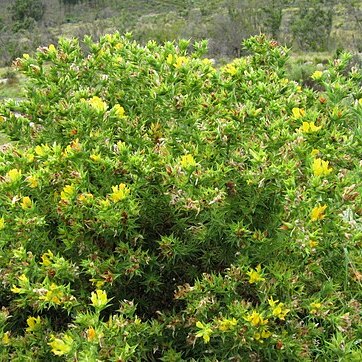An erect or ascending shrub usually 0.4-0.8(-1) m tall, strong, rigid, rather freely branched, up to more than 10 mm thick at the base. Young branches rather strong, white-woolly, densely leafy. Leaves lanceolate to broadly ovate, 12-22(-30) x 5-13(-17) mm, stiff, rigid, sharply spine-tipped, glabrous (not marginally ciliate), truncate to cordate and semi-amplexicaul at the base; both sides with 11-21 distinct, parallel veins, every second one being thinner than the other; margins prominent, smooth. Inflorescence a terminal head-like cluster with 4-8 flowers emerging from nearly the same point, surrounded by the uppermost leaves. One or more lateral branches often developing rapidly in the axil of some of the uppermost leaves, causing a sympodial branching system. Bracts and bracteoles lacking. Pedicel very short. Calyx tube campanulate, 5-7 mm long, covered with long, sparse, white hairs; lobes lanceolate, 5.5-11 mm long, glabrous on outer (hairy on inner) side, stiff, with 3-7 prominent, parallel veins, ending in a sharp spine more than 2 mm long. Petals bright yellow, turning bright red, partly covered with long, white pubescence; wing and keel claws about equal and 60% the length of the blades, respectively. Standard blade obtriangular-obovate, 10.5-14 x 7-10.5 mm, apically retuse, with long sericeous to tomentose pubescence on the back. Wing blades linear-spathulate, (8.5-)9.5-12 x 2.5-3.6 mm, broadest apically, rounded, with 3-4 longitudinal rows of minute folds on the upper part of the basal, narrow half. Keel blades (5.5-)6-7.2 x (3-)3.3-3.8 mm, sericeous-tomentose on most parts, with nearly straight upper margin. Pistil with elongate ovary, pubescent only basally on upper and lower sides; ovules 2. Pods lanceolate, 13-17.5 x 3.5-4.5 mm, sometimes slightly falcate, subglabrous, rather smooth.
More
Rigid shrub to 1 m. Leaves 1-foliolate, ovate, subamplexicaul, pungent, 11-21-veined from base. Flowers 4-8 in head-like cluster at branch tips, bright yellow, fading bright red, wings and keel hairy, calyx white-hairy, lobes lanceolate with prominent veins, sharply spine-tipped.
A low shrub. It grows 40-80 cm tall. It is a rigid plant and branches freely. The leaves are simple and sword shaped. The flowers are in groups of 4-8 at the ends of branches.

